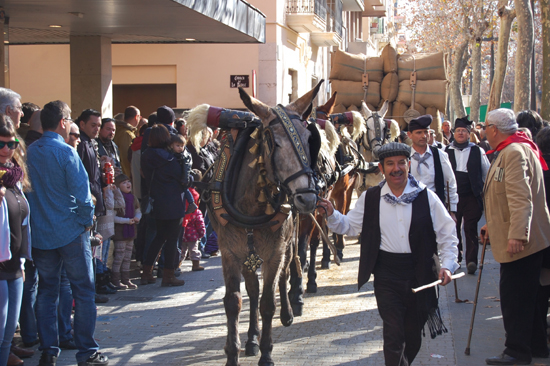The ‘Tres Tombs’, tradition when horses and carriages take to the streets of Catalan cities
On 17th of January, horses, ponies and donkeys, along with carriages, take to the streets of many cities in Catalonia to celebrate the ‘Tres Tombs’ parade (which would read as ‘Three Laps’). This tradition is in honor of Saint Anthony Abad, the patron saint of animals. Vilanovai la Geltrú, a coastal town 50km south of Barcelona, is one of the places where this festivity is lived to the fullest by local citizens. Year after year it plays host to the biggest ‘Tres Tombs’ parade in Catalonia. This year, nearly 100 carriages and over 300 horses, ponies and donkeys from all over Catalonia showed up at Vilanova on a sunny winter day and paraded through the packed streets of the city.

Vilanova i la Geltrú (CNA).- Catalonia is very rich in traditions. Some of them are known all over the world, such as the human towers, ‘La Diada’ the National Day on 11th of September, the Sant Jordi holiday on 23rd of April, and ‘pa ambtomàquet’ (Catalan tomato bread). Others are less known, even for some Catalans. Every 17th of January, animals such as horses, ponies and donkeys take to the streets of some Catalan towns to celebrate the ‘Tres Tombs’ parade (which would read as ‘Three Laps’ in English).
This old Catalan tradition is in honour of Saint Anthony Abad, patron saint of animals. Its roots can be found in the rural world when country folk travelled to the village with their carriages full of vegetables to offer some of their harvest to St. Anthony. In appreciation, the saint blessed their animals.
When the farmers pass in front of the Saint Anthony Church, the priest sprinkles holy water over the animals in order to bless them. After that, the carriages do three laps around the centre of the town and the main streets of the villages.
Celebrated in small towns and big cities alike
‘“Tres Tombs’ is a feast day that started in the 13th century”, explains Salvi Alba, the Secretary General of the ‘Tres Tombs’ Catalan Federation. This specific group embraces all the associations from all the towns of Catalonia where this tradition is celebrated. This federation is formed by some different cities. Some of them are big ones, like Barcelona, l’Hospitalet de Llobregat, Badalona, Terrassa or Sabadell. Medium-sized towns include Vilanovai la Geltrú, Esplugues de Llobregat, Igualada or Valls. Smaller rural towns are also represented, such as Deltebre, Anglesola, Cabrera de Mar or Prats de Lluçanès.
Alba affirms that this variety of association members is one of the strengths of the federation. “Even though some cities are bigger than others, all of them have something in common: they celebrate the ‘Tres Tombs’, with different dimensions and levels of attendance”.
Ironically, ‘Tres Tombs’ tends to be more important in smaller cities such as “Igualada, Valls, Anglesola or Esplugues de Llobregat where the festival is more traditional”, points out the Secretary General.
The city with the biggest ‘Tres Tombs’ parade is, however, Vilanovai la Geltrú. Located 50 kilometers south of Barcelona, this Mediterranean town lives this tradition to the full. “We can say actively and passively that there is no city in Catalonia where the parade is bigger in terms of the amount of animals on show than in Vilanova”, adds Alba.
Vilanovai la Geltrú is one of the eight cites that founded the Catalan ‘Tres Tombs’ Federation, and its headquarters are also located in this town. Saint Anthony is not only the patron saint of the animals, but also the patron saint of Vilanova. This is one of the reasons why this tradition is one of the most important holidays of the annual calendar for this coastal city.
A parade but also the town’s main winter party
‘Tres Tombs’ is not only a holiday; it is also the winter ‘Festa Major’ (local street festival) of Vilanovai la Geltrú. On 17th of January, all businesses in the city close and the people, in a festive spirit, take to the streets to welcome and enjoy the animals and the carriages.
“The winter ‘Festa Major’ is one of the most endearing holidays in the city”, recognised the Mayor of Vilanova i la Geltrú, Neus Lloveras. “In Vilanova, there are old traditions surrounding the world of horses and we believe that ‘Tres Tombs’ is a festivity that differentiates us from the other cities”, she added.
The ‘Tres Tombs’ is not only important for the citizens of Vilanova, but also for lovers of horses, donkeys and ponies all over Catalonia and even from some parts of Spain. And every year, the festival is a great way to project Vilanovai la Geltrú onto a larger stage. The Mayor of the city acknowledges this and recognises that the tradition “is a great way to introduce the city and is one of the points that makes us different”.
‘Tres Tombs’ is “in the DNA” of Vilanova
This year’s ‘Tres Tombs’ parade in Vilanovai la Geltrú started right on time with the animals blessing ceremony by the priest at the Saint Anthony Cathedral. Then, the horses, ponies and donkeys, along with all the carriages, took to the streets of the town and did three laps of the city. The municipal band of Vilanova put the soundtrack to the ‘Tres Tombs’ festival and the people cheered as the animals drove past. Children were allowed to approach the horses, and some tourists were surprised by what was going on in the town as nearly one hundred carriages and over 300 horses, ponies and donkeys took to the streets.
The organisation announced that participation this year doubled last year attendance and jockeys came from all over Catalonia to enjoy a beautiful festive day in Vilanova. “We value our culture, and we believe that the ‘Tres Tombs’ is in the DNA of this city as part of its identity”, concluded Neus Lloveras after the parade.